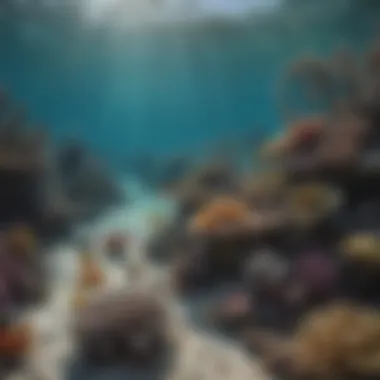Climate Change and the Great Barrier Reef: An In-Depth Study


Overview of Research Topic
Brief Background and Context
The Great Barrier Reef, spanning over 344,400 square kilometers, is the largest coral reef system on the planet. It is home to an extensive array of marine species, including fish, corals, and sea turtles, making it one of the most biodiverse ecosystems on Earth. However, this remarkable natural wonder faces increasing threats from climate change. Various studies have documented how factors such as rising sea temperatures and ocean acidification have resulted in the degradation of coral communities. Furthermore, the effects of extreme weather events, such as cyclones, have become more frequent and intense, compounding the challenges faced by this delicate ecosystem.
Importance in Current Scientific Landscape
Understanding the impacts of climate change on the Great Barrier Reef is vital for numerous reasons. Firstly, it provides critical insights into the resilience of coral ecosystems and their ability to adapt to changing conditions. Secondly, the reef plays a significant role in supporting local economies through tourism and fishing industries. Lastly, the knowledge gained from studying this biosphere may offer broader implications for global conservation strategies.
Methodology
Research Design and Approach
This analysis employs a multi-disciplinary approach, integrating perspectives from marine biology, environmental science, and socio-economics. By combining data from various disciplines, the study aims to paint a holistic picture of the current status and projected future of the Great Barrier Reef under the influence of climate change.
Data Collection Techniques
To achieve comprehensive insights, a range of techniques will be utilized:
- Field observations and long-term monitoring studies to track changes in coral health and marine biodiversity.
- Satellite imagery for assessing changes in sea temperature and physical alterations to the reef.
- Surveys and interviews with local communities, providing a human perspective on economic dependence and environmental stewardship.
This structured and detailed approach enables a thorough understanding of the ongoing impact of climate change on this vital ecosystem.
Preface
The topic of climate change and its effects on the Great Barrier Reef is not just significant; it is crucial for understanding one of the planet's most vital ecosystems. The Great Barrier Reef, a UNESCO World Heritage Site, is recognized for its incredible biodiversity and ecological importance. However, it is increasingly threatened by climate change factors, such as rising sea temperatures and ocean acidification.
This article aims to provide a comprehensive analysis of how these changes affect the reef and its marine life. By reviewing scientific research and observations, the article highlights specific elements like coral bleaching and habitat degradation, which are direct results of climate impact. Understanding these issues is essential, as they also have profound implications for local economies reliant on marine tourism and fishing.
As we examine this topic, it is important to recognize the benefits of safeguarding the reef. Healthy coral ecosystems contribute significantly to biodiversity, carbon storage, and coastal protection. They form a barrier against harsh weather and support various marine species, making them indispensable for ecological balance.
Additionally, the conversation around conservation strategies is crucial. It involves governmental actions, community participation, and educational efforts to protect and restore the reef. These aspects are explored in detail throughout the article, offering insight into both successes and ongoing challenges.
"When we talk about climate change's impact, we cannot overlook the consequences on the Great Barrier Reef. It is a reflection of our environmental priorities and a call to action for protection strategies."
The following sections will delve deeper into the mechanisms of climate change, the current state of the reef, and the socio-economic consequences stemming from environmental changes. The intent is to foster a deeper understanding of the complex interactions within marine ecosystems, particularly the Great Barrier Reef.
Understanding Climate Change
Understanding climate change is essential for grasping its impact, especially in relation to the Great Barrier Reef. This section lays the groundwork for comprehending how climate change operates and its wide-ranging effects. It highlights relevant mechanisms, trends, and ramifications affecting this significant marine ecosystem. A thorough understanding of climate change enables better strategies for future sustainability and conservation efforts.
Definition and Mechanisms
Climate change refers to long-term alterations in temperature, precipitation, wind patterns, and other elements of the Earth's climate system. These changes can result from natural processes and human activities. The primary driver of recent climate changes is the increase in greenhouse gases, particularly carbon dioxide and methane, linked to industrial activities, deforestation, and agriculture.
The mechanisms behind climate change include:
- Greenhouse Gas Emissions: These gases trap heat in the Earth's atmosphere, leading to increased global temperatures.
- Feedback Loops: Certain effects, like melting ice caps, reduce the Earth's albedo (its reflectivity), causing more heat absorption and further warming.
- Ocean Circulation Changes: Alterations in ocean currents can affect climate patterns and the distribution of marine ecosystems, ultimately impacting the reef.
Global Temperature Trends
Global temperatures have shown a clear upward trend over the past century. Data indicate that the average surface temperature has increased by approximately 1.2 degrees Celsius since the late 19th century. The ramifications of these rising temperatures are profound for marine ecosystems like the Great Barrier Reef.
Some critical trends include:


- Rising Sea Surface Temperatures: Higher ocean temperatures are a significant factor in coral bleaching, which weakens coral systems and increases mortality rates.
- Increased Frequency of Extremes: The rise in temperature has contributed to more frequent and severe heat waves, storms, and droughts, affecting ecosystems and species adaptation.
- Long-term Impacts: Prolonged exposure to elevated temperatures can lead to permanent changes in species distribution and ecosystem dynamics.
Impacts on Marine Environments
Climate change poses severe threats to marine environments, particularly coral reefs. The Great Barrier Reef is not an exception. Various impacts are observable:
- Coral Bleaching: As ocean temperatures rise, corals expel the symbiotic algae living within them, leading to bleaching. This phenomenon can cause widespread coral death if prolonged.
- Ocean Acidification: Increased carbon dioxide absorption by oceans leads to acidification, which adversely affects marine organisms, particularly those with calcium carbonate structures, like coral and mollusks.
- Habitat Disruption: Changes in temperature and currents can alter habitats, forcing marine species to migrate or adapt, which may not always be feasible.
According to the Intergovernmental Panel on Climate Change (IPCC), coral reefs could face severe degradation by 2050 if current trends continue.
In summary, understanding climate change is imperative for evaluating its impacts on the Great Barrier Reef. As we explore the nuances of how climate factors affect marine environments, we can highlight further implications, ultimately aiding in preparation and response strategies.
The Great Barrier Reef: An Overview
The Great Barrier Reef is a unique ecosystem that holds both geographical and biological importance. Covering over 344,000 square kilometers, this reef located off the coast of Australia is the largest of its kind in the world. Understanding its significance goes beyond its size; it is a complex network consisting of coral reefs, islands, and marine life, making it a vital topic for discussion in the context of climate change. The health of the reef reflects broader environmental conditions and serves as an indicator of marine ecosystem vitality.
Geographical and Biological Significance
The geographical location of the Great Barrier Reef sustains diverse habitats. Its numerous islands and cays provide safe harbors for various species. The reef acts as a barrier against strong ocean currents, creating protected areas that house a multitude of marine organisms. The environmental conditions, including warm clear waters and sunlight penetration, facilitate the growth of corals, which are foundational to the entire ecosystem. The biological significance is extreme; it supports thousands of species, some of which are endemic, meaning they are not found anywhere else on Earth.
Furthermore, the reef contributes to the local climate by influencing weather patterns in the region. For example, it helps to buffer coastal areas from storms, protecting both environmental resources and human settlements. This geographical feature significantly impacts the marine biosphere's health, directly linking its status to climate variables.
Biodiversity Hotspot
The Great Barrier Reef stands as a biodiversity hotspot, housing over 1,500 species of fish, 400 types of coral, and numerous other marine life forms. This incredible variety makes it one of the most significant marine environments globally. Each species plays a specific role, maintaining a delicate balance within the ecosystem.
Corals, often referred to as the architects of the reef, build the structure that provides habitat for countless aquatic organisms. The interactions among these species contribute to ecosystem services, which are essential for maintaining water quality and supporting fisheries.
- Coral Reefs: Form the foundation for marine life.
- Fish Species: Help keep algae levels in check, ensuring coral health.
- Marine Mammals: Include species like turtles and dolphins, adding to the ecosystem's complexity.
The loss of biodiversity due to climate change poses a significant threat, not just to the reef, but also to the global marine system. Mitigating factors such as ocean acidification and rising sea temperatures has emerged as a pressing requirement to maintain the integrity of this vital ecosystem.
"The Great Barrier Reef is not only a national treasure but also a global ecological asset. Its degradation would signal severe implications, not only for Australia but for marine biodiversity worldwide."
Current State of the Great Barrier Reef
The current state of the Great Barrier Reef is a vital aspect of understanding how climate change affects this ecosystem. As the world’s largest coral reef system, the reef supports a diverse range of marine life and plays a crucial role in the local economy, particularly through tourism and fishing. Identifying the health and stability of this natural wonder is essential for evaluating the broader implications of environmental changes. The two primary areas of focus are coral health and degradation and the impact on fish populations and habitat loss.
Coral Health and Degradation
Corals are the foundation of the Great Barrier Reef’s ecosystem. Their health is critical to maintaining biodiversity and supporting various marine species. However, rising sea temperatures are leading to frequent coral bleaching events. Bleaching occurs when corals expel the symbiotic algae living within their tissues, which provide them with nutrients and color. When subjected to higher-than-normal temperatures, corals undergo stress, resulting in this phenomenon. The consequence of widespread coral bleaching is profound, resulting in reduced coral cover and long-term ecosystem shifts.
Current research indicates that over 50% of the corals have suffered bleaching since the 1990s. The degradation of coral health not only threatens the corals themselves but also disrupts the entire marine environment dependent on this habitat. Corals provide essential services such as coastal protection, habitat for juvenile fish, and natural beauty that attracts tourism. Without effective interventions, the degradation of coral health may escalate, leading to loss of species and overall biodiversity decline.
Fish Populations and Habitat Loss
Fish populations are directly correlated to the health of coral ecosystems. As coral reefs degrade, fish species that rely on healthy reefs for breeding and feeding face significant threats. Studies reveal notable declines in fish populations, as many species are experiencing habitat loss due to the deterioration of coral structures. The intricate interplay of various species with their environment is vital for sustaining the reef ecosystem.
Loss of habitat means fewer fish for local fisheries, which poses socioeconomic threats to communities that depend on these resources.
- The area of the reef where fish populations are most vulnerable includes:
- Shallow waters with abundant coral growth
- Regions prone to human activity, such as fishing and tourism
- Areas affected by pollution and runoff
The implications of decreased fish populations extend beyond immediate environmental concerns. It influences local economies that rely on fishing to sustain livelihoods and food security for communities in coastal regions. If fish populations continue to decline, the repercussions will affect a range of interconnected systems from the economy to the overall health of marine ecosystems.
"Sustaining the Great Barrier Reef is not just about protecting corals; it is about ensuring the survival of countless marine species that define the health of oceanic ecosystems."


Addressing the current state of the Great Barrier Reef demands attention. Understanding coral health and fish populations is crucial for creating effective conservation strategies. Without urgent action, future generations may inherit a vastly different reef, one lacking the vibrant ecosystems that once flourished and the industries that depend on them.
Effects of Climate Change on the Reef
The Great Barrier Reef is a complex and delicate ecosystem that faces significant threats from climate change. Understanding the effects of climate change on this natural wonder is crucial not only for its conservation but also for the many communities that rely on its health for their livelihoods. This section explores how climate change, through various mechanisms, adversely impacts the reef, emphasizing coral bleaching, ocean acidification, and increased cyclonic activity.
Coral Bleaching Events
Coral bleaching is a direct response of corals to stress. When the water temperatures rise even slightly above normal levels, corals expel the symbiotic algae known as zooxanthellae. These algae are essential for coral health as they provide up to 90% of the energy that corals need through photosynthesis. Once lost, corals turn white, which is why the phenomenon is called bleaching.
The frequency and severity of bleaching events have increased due to climate change. For instance, severe bleaching occurred in 2016 and 2017, leading to the loss of significant portions of the reef. A key factor to consider is that coral recovery requires not only time but also suitable environmental conditions. If high temperatures persist, recovery becomes nearly impossible.
"Coral bleaching represents a significant indicator of the overall health of marine ecosystems, signaling detrimental changes that could affect biodiversity and ecosystem sustainability."
Ocean Acidification Consequences
The increase in carbon dioxide levels in the atmosphere also leads to ocean acidification. When CO2 dissolves in seawater, it lowers the pH and alters the chemical balance of the ocean. This change affects coral's ability to produce calcium carbonate, which is essential for building their skeletons. As ocean acidity increases, the availability of carbonate ions decreases, making it harder for corals to maintain their structures.
This phenomenon can weaken coral reefs, making them more susceptible to breakage and less able to support the vast array of marine life that depend on them. As fish and other marine life lose their habitats, the implications ripple through the entire ecosystem, threatening both biodiversity and the services these environments provide to humans, including tourism and fisheries.
Increased Cyclonic Activity
Climate change is also contributing to increased cyclonic activity. Warmer ocean temperatures can lead to stronger and more frequent storms. These cyclones pose a direct threat to the Great Barrier Reef, as intense storms can cause physical damage to coral structures and disrupt the coastal ecosystems.
In addition to physical destruction, severe weather events can result in sediment run-off and pollution, further compromising coral health. The aftermath of such storms can accelerate the degradation of the reef, thus affecting its resilience and ability to recover from ecological stressors.
Overall, the effects of climate change manifest in complex and interrelated ways, creating urgent challenges for the future of the Great Barrier Reef. Understanding these dynamics is essential for informing effective conservation strategies and ensuring the survival of this iconic ecosystem.
Biodiversity Implications
Biodiversity plays a critical role in maintaining ecological balance. The Great Barrier Reef, known for its rich variety of marine life, hosts thousands of species, including reef-building corals, fish, mollusks, and other invertebrates. The implications of climate change on this biodiversity are profound and far-reaching. As temperatures rise and ocean chemistry shifts, many species face significant threats to their survival. The loss of biodiversity can disrupt the delicate interplay of ecosystems, leading to unforeseen consequences across the marine environment and beyond.
One significant aspect to consider is the species vulnerability. Each species within the reef's ecosystem has unique adaptations that allow them to thrive. However, changing conditions such as increased water temperatures and acidity can exceed these thresholds. Certain coral species, like Acropora, are more susceptible to bleaching. Fish populations, including the clownfish and parrotfish, also show sensitivity to habitat changes, which can affect their reproductive success. Vulnerability is not exclusive to specific species; entire assemblages can decline, leading to a loss of genetic diversity.
Another consideration is the loss of ecosystem services. The Great Barrier Reef offers essential services such as coastal protection, fisheries, and tourism opportunities. Its biodiversity underpins these functions. Healthy coral reefs act as barriers, protecting coastlines from erosion and storm surges. Moreover, they support important fish populations, contributing to local and commercial fishing industries. If biodiversity declines, the corresponding services will diminish, leading to economic and environmental repercussions.
"Biodiversity loss in the Great Barrier Reef not only threatens marine life but also jeopardizes the livelihoods of communities dependent on these ecosystems."
In summary, the implications of biodiversity in the context of the Great Barrier Reef are immense. Protecting the genetic richness of this area is crucial for resilience against climate change. Without active conservation efforts, both species and essential services may face irreparable losses, highlighting the urgent need for awareness and action.
Socioeconomic Consequences
The socioeconomic consequences of climate change on the Great Barrier Reef are significant and multifaceted. This discussion involves not only economic considerations but also social and cultural aspects that directly affect communities reliant on the reef's resources. Understanding these implications is crucial for framing effective policies and conservation strategies.
Impact on Tourism
The Great Barrier Reef is one of the most visited natural wonders in the world, attracting millions of tourists annually. This tourism industry is a major economic driver for the region, generating billions in revenue and providing employment to countless individuals.
However, climate change poses serious risks to this sector. Coral bleaching events and reduced marine biodiversity detract from the reef's aesthetic and ecological appeal. If coral systems continue to degrade, tourism, which relies heavily on the health of these ecosystems, will suffer. Tourists often seek vibrant marine life and pristine coral gardens, and their experiences are tied to the reef’s condition.
According to recent reports, if current trends continue, visitor numbers may decline, leading to significant economic loss. Businesses that depend on reef tourism, such as diving schools and tour operators, face uncertainty. It is crucial for policymakers and stakeholders to promote sustainable practices that mitigate further damage to the reef and ensure the long-term viability of this vital industry.
Fisheries and Local Economies
Fisheries represent another critical component of the socioeconomic framework surrounding the Great Barrier Reef. Local communities have relied on fishing for generations as a primary source of food and livelihood. Fish populations depend on the reef’s ecological balance, which is increasingly threatened by climate change through rising sea temperatures and ocean acidification.


Changes in marine species distribution can lead to losses in catch and disruptions of traditional fishing practices. Such developments can significantly impact local economies, as many fishermen and women depend on consistent fish stocks for their incomes.
Additionally, these fisheries contribute to food security in surrounding communities. A decline in fish populations can lead to higher prices and reduced access to fresh seafood, creating economic strain. The interdependencies between reef health and community economics necessitate urgent action to conserve the reef while promoting sustainable fishing practices.
"Protecting the Great Barrier Reef is not only an environmental issue, but also a socio-economic necessity."
In summary, the socioeconomic consequences of climate change on the Great Barrier Reef reveal the importance of addressing the issues at hand. Sustainable development efforts that integrate both tourism and fisheries management are essential to protect the livelihoods of local communities and ensure the reef's resilience for future generations.
Current Conservation Strategies
The preservation of the Great Barrier Reef necessitates multifaceted conservation strategies due to the complexity of its ecological systems. These strategies aim to counteract the adverse effects of climate change while promoting a sustainable coexistence between humans and marine life. It is essential to examine different approaches, such as government actions and community involvement, as they play a vital role in conserving this important ecosystem.
Government and Legislative Actions
Government policies form the backbone of conservation efforts. Various legislation and frameworks are designed to protect the reef from environmental degradation. The Australian government has established the Great Barrier Reef Marine Park Authority, which regulates activities within the park. This authority enforces zoning plans that limit harmful activities, such as overfishing, tourism pressures, and industrial runoff.
In addition, the Australian Government's Reef 2050 Plan outlines ambitious goals to protect and restore the reef over the next three decades. Key components include:
- Water Quality Improvement: Targeted measures to reduce sediment and nutrients entering the reef.
- Biodiversity Protection: Safeguarding critical habitats and ensuring the recovery of species at risk.
- Research Initiatives: Funding for research that aims to understand the complex interactions between climate, biodiversity, and human activities.
International cooperation is also a critical element. Changes in global policies regarding carbon emissions can have profound effects on climate change, which in turn impacts the reef. Therefore, participation in global agreements, like the Paris Agreement, is necessary to align local conservation efforts with broader climate objectives.
Community Involvement and Education
Community engagement is crucial in conservation efforts. Local populations can contribute significantly to the protection and management of the Great Barrier Reef. Programs that promote education and awareness about the fragility of marine ecosystems are vital to fostering a sense of stewardship among residents and tourists.
Organizations, such as the Australian Marine Conservation Society, offer educational workshops and community events aimed at increasing public knowledge regarding reef conservation. Examples include:
- Reef Guardian Schools: Programs designed to educate students on marine science and encourage them to participate in conservation activities.
- Volunteer Programs: Initiatives that allow residents to get involved in reef monitoring, coral planting, and clean-up efforts.
Community actions often result in a stronger commitment to environmental stewardship. When people understand the challenges facing the reef, they are more likely to support sustainable practices.
Future Projections
Understanding future projections is essential to assess the long-term implications of climate change on the Great Barrier Reef. This analysis goes beyond recognizing the immediate effects and emphasizes the potential scenarios that might unfold. By examining these projections, stakeholders can make informed decisions, contribute to conservation efforts, and establish policies aimed at mitigating threats to this iconic ecosystem.
Potential Scenarios for the Reef
The future of the Great Barrier Reef hinges on a number of variables shaped by climate change. The following scenarios illustrate possible outcomes based on current trends:
- Continued Coral Bleaching: Without significant intervention, coral bleaching events may occur more frequently and severely, leading to widespread mortality. This could decimate coral populations and disrupt the entire marine ecosystem.
- Adaptation of Species: Some marine species may adapt to changing conditions. For instance, certain corals might develop heat-resistant traits, allowing them to survive in higher temperatures. However, this adaptation is not guaranteed and may not apply to all species.
- Decline in Biodiversity: As consecutive bleaching events take a toll on coral ecosystems, the biodiversity that relies on these habitats may diminish. The loss of species could have cascading effects, altering food webs and ecosystem functionality.
- Increased Ocean Acidification: With higher CO2 levels, ocean acidification could further harm calcifying organisms. A decline in mollusks and carbonate-producing organisms would impact many marine species dependent on these crucial components.
These scenarios underscore the critical need for monitoring and research to anticipate changes and guide effective conservation measures.
Strategies for Resilience
Amidst these uncertain futures, developing resilience strategies is paramount. These approaches can bolster the reef's health and enhance the survival chances of marine species. Some key strategies include:
- Enhanced Monitoring: Implementing comprehensive monitoring programs will allow scientists to track changes in reef health, biodiversity, and environmental conditions.
- Active Restoration Initiatives: Coral restoration projects, such as coral gardening and artificial reefs, can revitalize damaged areas. These methods support coral population recovery and promote ecosystem stability.
- Sustainable Fishing Practices: Regulating fishing activities can prevent overfishing, which often exacerbates the decline of vulnerable marine species. Promoting sustainable practices will help maintain population levels and resilience of the ecosystem.
- Public Awareness and Local Engagement: Educating local communities and tourists about environmental impacts fosters stewardship and support for conservation efforts. Engaging local populations in reef protection initiatives can lead to better management and sustainable tourism.
Ending
In summarizing the discussion on the impact of climate change on the Great Barrier Reef, it becomes evident that this topic is not merely an environmental concern; it embodies broader implications for biodiversity, local economies, and global ecosystems. Addressing this subject is critical for multiple reasons.
First, the complex interactions between climate change and coral ecosystems need to be clearly understood. Coral bleaching, ocean acidification, and extreme weather events are just a few of the pressures being placed on this delicate marine environment. Each of these factors contributes to the degradation of the reef, threatening diverse species that rely on the ecosystem.
Second, the socioeconomic ramifications of environmental changes deserve attention. Tourism, a major financial resource for the region, hinges on the health of the reef. Damage caused by climate change could lead to significant declines in visitor numbers, negatively impacting local businesses and communities. The connection between the reef's state and economic stability is undeniable.
Additionally, the future of conservation strategies is a focal point. For effective management, understanding how to increase resilience among coral communities and enhance recovery strategies is essential. Projects aimed at bolstering local awareness and promoting sustainable practices are vital steps toward preservation.
Lastly, this topic compels stakeholders—government agencies, non-profits, and local communities—to take action. Collaborative efforts, driven by a thorough analysis of the challenges, can lead to innovative solutions and sustain the reef for future generations.
"The health of the Great Barrier Reef is a barometer for the overall health of our planet."



